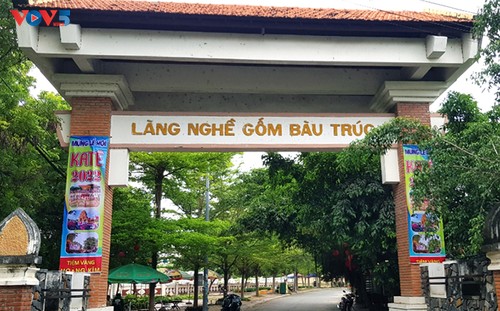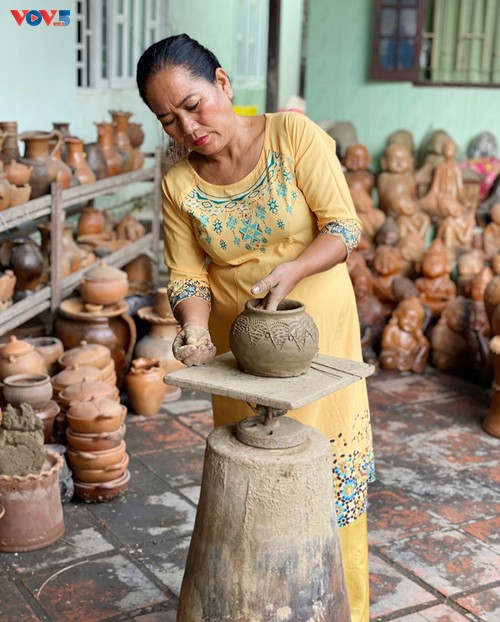 The gate of Bau Truc village (Photo: Ngoc Anh/VOV5) The gate of Bau Truc village (Photo: Ngoc Anh/VOV5)
|
Dang Sinh Ai Chi, Deputy Chairwoman of Phuoc Dan town’s People’s Committee, said it’s impossible to ignore pottery making when talking about the traditional crafts of the Cham people.
An important feature of Cham pottery is the spiritual world of beliefs, customs, and culture depicted on their pottery products.
Popular patterns often seen on Bau Truc pottery are Apsara dancers, Cham deities like Shiva, linga-yoni images, Cham dancers, and musicians playing the saranai trumpet.
The Cham art of pottery-making in Bau Truc village has been recognized as a national intangible cultural heritage, said Ms. Ai Chi.
She said, “The unique thing about Bau Truc pottery is that it’s all handmade. The dexterity and skill of Bau Truc artisans produce unique pottery products.”
 Artisans in Bau Truc village demonstrate the pottery-making method. (Photo: Ngoc Anh/VOV5) Artisans in Bau Truc village demonstrate the pottery-making method. (Photo: Ngoc Anh/VOV5)
|
Bau Truc potters have to walk around a product to create it. The longer it takes, the rounder and better-proportioned the item will be. On average, a potter walks 5 to 8 km a day. The product is open-air fired without glazing.
The potter sprays on color extracted from cashew nut oil or dandelions. Finished items are typically colored reddish yellow, pinkish red, grayish black, or brown.
Since every product is shaped by hand without using a mold, each Bau Truc ceramic product is unique.
Dang Thi Dam, a Bau Truc pottery maker, said Bau Truc pottery is distinctive from products of other craft villages.
“The process of making Bau Truc ceramic products includes swatting and then soaking the clay, mixing the clay with sand and water, drawing patterns, drying, and firing. My whole family is involved in the craft. I’m the 4th generation. We’ve diversified our products to include reliefs, fine art items, and vases. Our products are getting better and better,” said Dam.
Van Cong Hoa, Deputy Director of the provincial Department of Culture, Sports and Tourism, said if Bau Truc pottery village is not protected, it will likely be lost in the future.
"This is an intangible cultural heritage unique in the world. No other country has a pottery-making art like Bau Truc’s. The Ministry of Culture, Sports and Tourism has applied to UNESCO for recognition of the craft as an intangible cultural heritage in need of urgent protection. If recognized by UNESCO, both the Vietnamese government and UNESCO will create policies and directives to preserve and promote Bau Truc pottery village,” said Hoa.
At the 17th session of the Inter-governmental Committee for the Safeguarding of Intangible Cultural Heritages in Rabat, Morocco, the pottery-making art was inscribed by UNESCO in the list of intangible cultural heritages in need of urgent safeguarding.